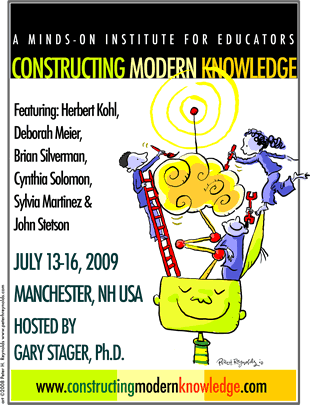Thinking Stick, Jeff Utecht, wrote a blog post today that really resonated with me. Just back from the EARCOS Teacher’s Conference (ETC), Utecht reflects on why he attended only two session, other than the four that he presented.
It’s the first conference that I’ve gone to where I truly did not “do” the conference. Other than my own four presentations I only went to two others….one if you don’t count Kim’s.
I’ve been trying to wrap my head around why I didn’t feel motivated to go to more sessions. I like learning so what was my problem?
Then it hit me…..I don’t like learning alone!
I don’t like Learning Alone! « The Thinking Stick
|
|
|
|
I’ve had this same experience, though I am more likely to attribute it to fatigue. But the thing is, if learning is the only reason we are going to conferences, well, then, who needs them. I have been at home most of the day, sitting in my office and working. Principally I have been preparing for tomorrow’s ISTE Eduverse talk show in Second Life. As a result, I’ve been teaching myself how to build and install animations and gestures and to face the person I am talking to. I also learned to install a captcha on the Education Podcast Network, to try to prevent spam from getting in.
Jeff says, “I don’t like learning alone.” At no point did I feel that I was learning alone today. At least, I was learning from blog posts and YouTube videos posted by people just like me.
I think that the loss of social interaction that results from unreliable Internet at conferences is a huge part of the issue. But I also suspect that we are becoming accustomed to working within a greater brain — no longer limited by our own dendrits. We have become accustomed to having quiet conversations within our networks, to asking questions and getting answers back from people we respect, and to contributing knowledge and insights to a larger community — and not just for the sake of helping others, but for the value-added that occurrs when it comes back.
<em>It’s like trying to learn with half your brain tied behind your back</em> — or a full three-quarters in my case. I think that his extension to students is a valid one.
And then I started thinking about our students. Our students who spend there day not just in front of screens but connecting with people, learning in the moment and creating content.
They play together, learn together, work together, and grow together. Then, in the classroom, we value the space between their desks more than their tendency to connect and the power of it.
I think that this is something that conferences need to understand and facilitate. It’s no longer merely about sharing. Today the conference has to be about growing the knowledge.
Added Later: Kim Cofino made a particularly interesting contribution to this conversation here:
I love learning. I used to love professional conference too – mostly because they were a great place to learn. But, last weekend, at our regional teacher’s conference (ETC), I made a realization… (more here)








 Low Cost Computing — Re: One Laptop Per Child
Low Cost Computing — Re: One Laptop Per Child

 I’m probably a bit late with this, and only have a few minutes, but I got this news release this morning (5:15AM GMT+3) and am very excited about the potentials. I got the link from MIT Press Journals intern, Johna Picco, announcing IJLM, The International Journal of Learning and Media. Here is a snipit from the release and a link.
I’m probably a bit late with this, and only have a few minutes, but I got this news release this morning (5:15AM GMT+3) and am very excited about the potentials. I got the link from MIT Press Journals intern, Johna Picco, announcing IJLM, The International Journal of Learning and Media. Here is a snipit from the release and a link.

 I ran across both of these in the last 24 hours, both from education leaders I respect a great deal. First is Dr. Gary Stager’s
I ran across both of these in the last 24 hours, both from education leaders I respect a great deal. First is Dr. Gary Stager’s  If you are a superintendent or principal, you know that your students are or will be using the Web, cell phones and other technologies to connect and create social networks. But do you also know the profoundly transformative opportunities for learning these technologies offer? Do you understand fully how schools and classrooms are being challenged by these new technologies and what the implications are for your teachers and students?
If you are a superintendent or principal, you know that your students are or will be using the Web, cell phones and other technologies to connect and create social networks. But do you also know the profoundly transformative opportunities for learning these technologies offer? Do you understand fully how schools and classrooms are being challenged by these new technologies and what the implications are for your teachers and students?

